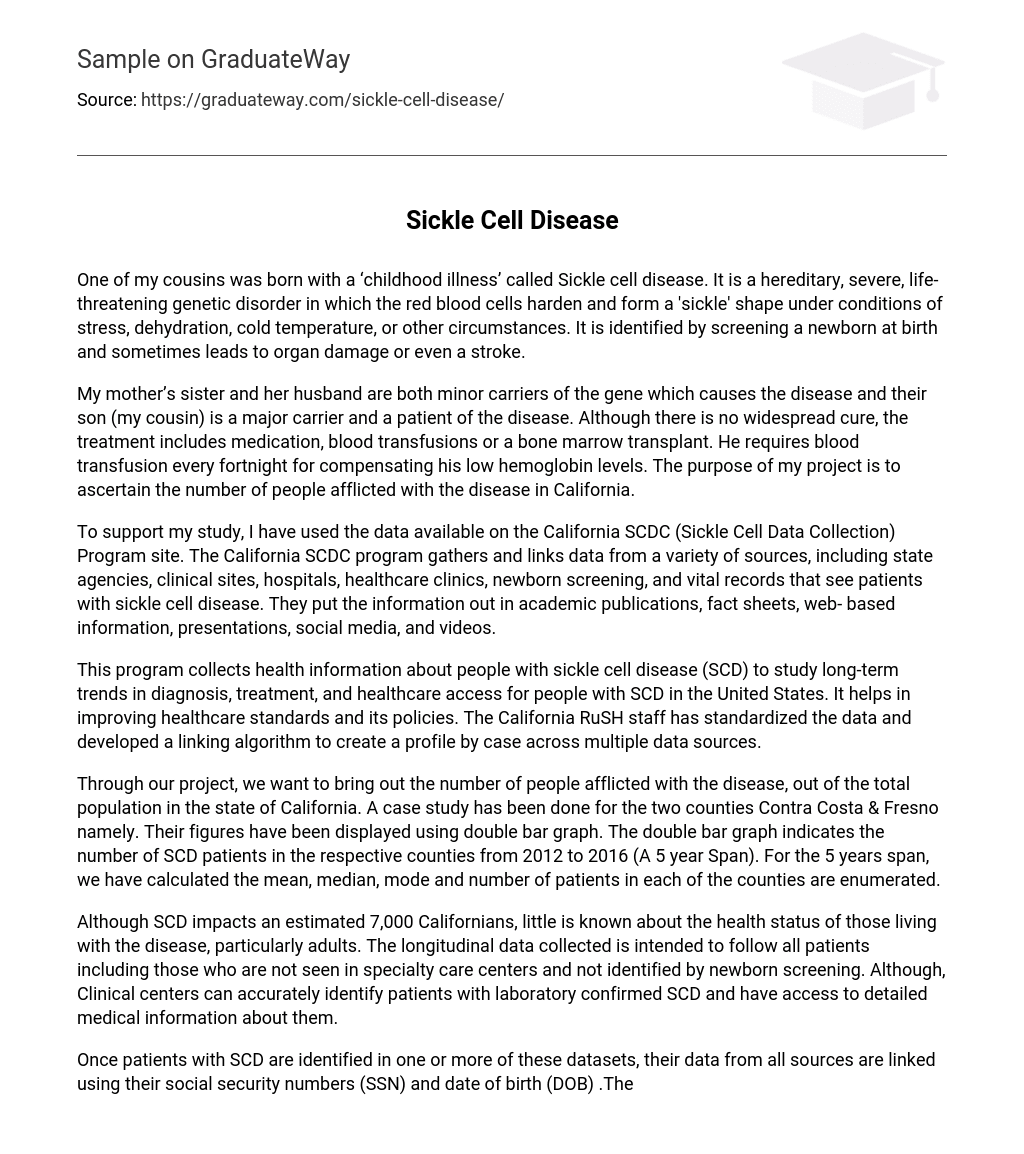One of my cousins was born with a ‘childhood illness’ called Sickle cell disease. It is a hereditary, severe, life-threatening genetic disorder in which the red blood cells harden and form a ‘sickle’ shape under conditions of stress, dehydration, cold temperature, or other circumstances. It is identified by screening a newborn at birth and sometimes leads to organ damage or even a stroke.
My mother’s sister and her husband are both minor carriers of the gene which causes the disease and their son (my cousin) is a major carrier and a patient of the disease. Although there is no widespread cure, the treatment includes medication, blood transfusions or a bone marrow transplant. He requires blood transfusion every fortnight for compensating his low hemoglobin levels. The purpose of my project is to ascertain the number of people afflicted with the disease in California.
To support my study, I have used the data available on the California SCDC (Sickle Cell Data Collection) Program site. The California SCDC program gathers and links data from a variety of sources, including state agencies, clinical sites, hospitals, healthcare clinics, newborn screening, and vital records that see patients with sickle cell disease. They put the information out in academic publications, fact sheets, web- based information, presentations, social media, and videos.
This program collects health information about people with sickle cell disease (SCD) to study long-term trends in diagnosis, treatment, and healthcare access for people with SCD in the United States. It helps in improving healthcare standards and its policies. The California RuSH staff has standardized the data and developed a linking algorithm to create a profile by case across multiple data sources.
Through our project, we want to bring out the number of people afflicted with the disease, out of the total population in the state of California. A case study has been done for the two counties Contra Costa & Fresno namely. Their figures have been displayed using double bar graph. The double bar graph indicates the number of SCD patients in the respective counties from 2012 to 2016 (A 5 year Span). For the 5 years span, we have calculated the mean, median, mode and number of patients in each of the counties are enumerated.
Although SCD impacts an estimated 7,000 Californians, little is known about the health status of those living with the disease, particularly adults. The longitudinal data collected is intended to follow all patients including those who are not seen in specialty care centers and not identified by newborn screening. Although, Clinical centers can accurately identify patients with laboratory confirmed SCD and have access to detailed medical information about them.
Once patients with SCD are identified in one or more of these datasets, their data from all sources are linked using their social security numbers (SSN) and date of birth (DOB) .The patient and their SSN are linked using variables such as diagnosis, DOB, sex, and facility. These are used to determine the correct SSN for those identified through newborn screening or who were reported without an SSN by clinics.
Even, in regions with excellent clinical care centers, a sizeable portion of patients with SCD receive care in other settings. Therefore, data from clinical care centers alone is not accurate to reflect the general SCD population of that area. This is the main hindrance in the data collection process of the SCDC program. To reduce this hindrance the administrative data relies on International Classification of Disease (ICD) codes to identify patients with SCD.
The sample data collected for Sickle Cell disease in Contra Costa County is not significant at the level of 10% there is not enough evidence to reject the mean number of cases in Contra Costa County is equal to 261.2. We don’t have enough evidence to support the idea that the mean no. of cases is more than 261.2.
We can safely conclude, that the cases in of SCD in California are significant in numbers. If the SCD test can be made mandatory for the general public at large, the onslaught of fresh cases could be arrested. We think the biggest challenge we faced while drawing up the blue print of the project was looking up for the requisite data for the project . We wished if we had more time a more detailed analysis of the life span of a SCD patient along with the blood transfusion frequency could also be put down statistically. Overall, it has been a great learning experience while working on this project with the valuable guidance received from our professor.





